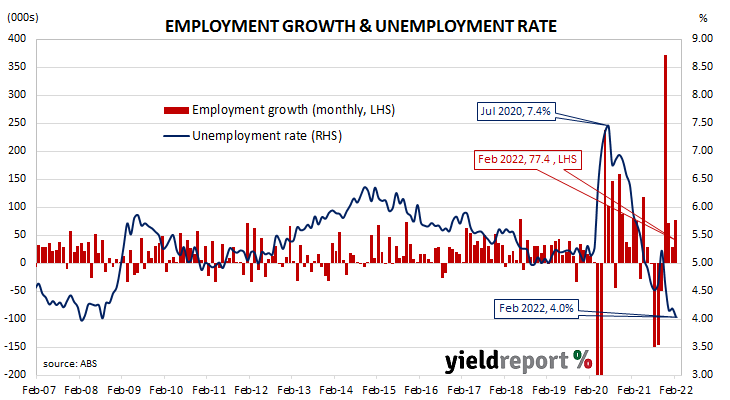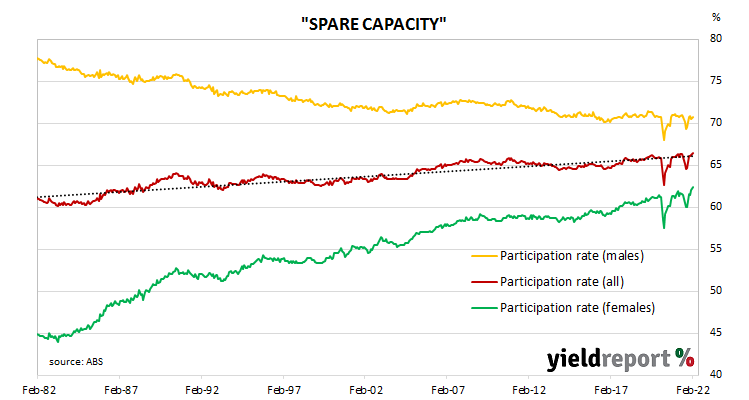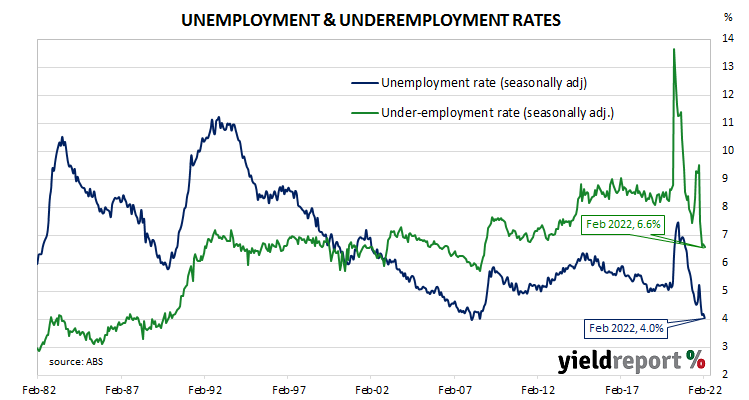Summary: Employment up 77,400 in February; rise greater than expected figure; a “robust” update, labour demand, supply both strong; participation rate rises to 66.4%; forward indicators point to further job market tightening; fewer jobseekers, larger workforce lowers jobless rate to 4.0%; fewer part-time, more full-time jobs; aggregate work hours up 8.6%; underemployment rate ticks down from 6.7% to 6.6%.
Australia’s period of falling unemployment came to an end in early 2019 when the jobless rate hit a low of 4.9%. It then averaged around 5.2% through to March 2020, bouncing around in a range from 5.1% to 5.3%. Leading indicators such as ANZ’s Job Ads survey and NAB’s capacity utilisation estimate suggested the unemployment rate would rise in the June 2020 quarter and it did so, sharply. The jobless rate peaked in July 2020 but fell below 7% a month later. It then trended lower through the remainder of 2020, 2021 and into 2022.
The latest Labour force figures have now been released and they indicate the number of people employed in Australia according to ABS definitions increased by 77,400 in February. The rise was greater than the 60,000 increase which had been generally expected and considerably more than January’s 28,300 increase.
“This is a very robust update on the labour market, not just in terms of robust labour demand but also the strong gains in labour supply with the participation rate hitting a record high of 66.45% at two decimal places,” said Westpac senior economist Justin Smirk.
Domestic Treasury bond yields generally increased on the day, although not at the ultra-long end and not quite as much as their US Treasury bond counterparts had overnight. By the close of business, the 3-year ACGB yield had gained 6bps to 2.11%, the 10-year yield had inched up 1bp to 2.57% while the 20-year yield finished 3bps lower at 2.92%.
In the cash futures market, expectations of any material change in the actual cash rate, currently at 0.05%, hardened in favour of rate rises in the second half of 2022. At the end of the day, contract prices implied the cash rate would not exceed the RBA’s 0.10% target rate until May and then rise to 0.59% by August. February 2023 contracts implied a cash rate of 1.56%.
“While the labour market is clearly tight, most forward indicators including job ads/vacancies and surveyed expectations are pointing to solid underlying demand for labour and therefore further incremental tightening in the labour market,” said Morgan Stanley Australia equity strategist Chris Read.
The participation rate rose from January’s 66.2% to 66.4%, as the total available workforce increased by 58,900 to 13.935 million. The number of unemployed persons decreased by 18,500 to 563,300; the lower jobless number and a larger number of people in the workforce resulted in the unemployment rate declining from 4.2% to 4.0%.
The aggregate number of work hours across the whole Australian economy increased significantly as 44,500 residents lost part-time positions and 121,900 residents gained full-time positions. In percentage terms, the total number of work hours rose by 8.6% after dropping by 8.8% in January. On a 12-month basis and after revisions, aggregate hours worked increased by 2.8% as 34,600 more people held part-time positions and 360,800 more people held full-time positions than in February 2021.
In recent years, more attention has been paid to the underemployment rate, which is the number of people in work but who wish to work more hours than they do currently. February’s underemployment rate ticked down from 6.7% to 6.6%.
The underutilisation rate, that is the sum of the underemployment rate and the unemployment rate, has a strong correlation with the annual growth rate of the ABS private sector wage index when advanced by one quarter. February’s underutilisation rate of 10.6% corresponds with an annual growth rate of about 4.1%.




